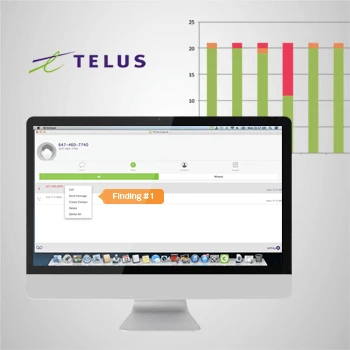What exactly is customer experience concept testing?
Customer experience concept testing validates new experience ideas before significant investment in development. We test early, non-technically working versions of the experience with your target audience to determine what resonates and what doesn't. This approach follows the Experience Thinking principle of starting with the intended experience rather than jumping into technology building.
Tip: Focus concept testing on experience value rather than interface preferences to identify concepts that will create lasting customer relationships.
How does concept testing differ from usability testing?
Concept testing answers 'why will I buy or engage?' while usability testing answers 'how do I use?'. Concept testing is perception-based research that explores preference and appeal, while usability testing is behavior-based research examining ease of use. We use concept testing to validate ideas before building them out into full workflows.
Tip: Use concept testing first to validate which ideas are worth developing into detailed prototypes for usability testing.
Why test concepts before full development?
Testing concepts early prevents development budget being spent on the wrong experience. Following Experience Thinking principles, we create early throwaway versions that answer whether the experience will suffice for users and meet business goals. This thorough understanding helps find the starting point before determining specific technical components.
Tip: Test concepts when you have enough experience design to support key workflows but before investing in full functionality.
What makes a concept ready for testing?
A testable concept captures the core experience journey without requiring working technology. Using Experience Thinking's holistic approach, concepts should represent how brand, content, product, and service elements connect to create the intended experience. Paper prototypes, wireframes, or simple mockups can effectively communicate the experience concept.
Tip: Include enough experience detail to test the complete user journey rather than individual interface elements.
How do you determine which concepts to test?
We identify concepts that represent different approaches to solving the same user need or achieving the same business goal. Following Experience Thinking methodology, we evaluate concepts across brand expression, content strategy, product functionality, and service delivery to ensure we're testing meaningfully different experience approaches.
Tip: Choose concepts that differ in strategic approach rather than superficial design elements to generate actionable insights.
What role does the Experience Thinking framework play in concept testing?
Experience Thinking provides the structure for holistic concept development and testing. We examine how each concept expresses brand personality, organizes content, delivers product value, and connects service touchpoints. This framework ensures concepts are tested as complete experiences rather than isolated features.
Tip: Map your concepts against all four Experience Thinking quadrants to identify which areas need strengthening before testing.
How detailed should concepts be for effective testing?
Concepts need enough detail to communicate the intended experience without getting distracted by implementation specifics. Following the Experience Thinking principle of creating the experience first, concepts should show the experience characteristics including timing, interaction, intensity, coverage, and meaning without requiring functional technology.
Tip: Focus concept detail on experience flow and value proposition rather than visual polish or technical functionality.
What research methods do you use for concept testing?
We use qualitative methods like concept walkthroughs, focus groups, and individual interviews to understand user reactions and preferences. Our approach combines structured concept presentation with open discussion to capture both immediate reactions and deeper reasoning behind preferences.
Tip: Choose qualitative methods when you need to understand the 'why' behind concept preferences rather than just measuring preference levels.
How do you structure concept testing sessions?
Sessions typically include concept presentation, guided exploration, preference discussion, and strategic questioning about value and appeal. We use funnel questioning techniques - starting with open reactions then drilling into specific details - to capture rich feedback about each concept's strengths and weaknesses.
Tip: Allow sufficient time for users to fully explore each concept rather than rushing through multiple options superficially.
What questions do you ask during concept testing?
We focus on open questions that reveal user mental models and value perceptions. Rather than asking leading questions like 'Do you think this concept is good?', we ask 'What stands out to you about this approach?' and 'How would this fit into your current process?' This approach reveals authentic user perspectives.
Tip: Prepare probing questions that help users articulate their reasoning rather than just collect preference votes.
How many concepts should we test at once?
We typically test 2-4 concepts to allow meaningful comparison without overwhelming participants. This range enables users to understand the differences between approaches while providing enough options to identify clear preferences and generate useful insights about what drives those preferences.
Tip: Test concepts that represent genuinely different strategic approaches rather than minor variations of the same idea.
How do you avoid bias in concept testing?
We use randomized concept presentation, neutral language, and structured questioning to minimize bias. Our approach focuses on understanding user reasoning rather than validating predetermined preferences. We also separate concept testing from implementation concerns to keep feedback focused on experience value.
Tip: Present concepts without indicating which one your organization prefers to get unbiased user reactions.
What's the ideal participant size for concept testing?
We typically work with 12-20 participants for qualitative concept testing, allowing us to identify clear patterns while maintaining focus on rich, detailed feedback. This size provides sufficient diversity of perspectives without requiring the statistical rigor needed for quantitative preference measurement.
Tip: Focus on participant quality and representation of your target audience rather than large sample sizes for concept validation.
How do you recruit the right participants for concept testing?
We recruit participants who match your target audience characteristics including demographics, psychographics, behaviors, and context of use. Our screening process ensures participants have relevant domain knowledge and genuine interest in the type of experience being tested.
Tip: Include participants who represent both current customers and potential new audience segments to understand broader market appeal.
What strategic insights does concept testing typically reveal?
Concept testing reveals which experience approaches resonate with your audience, why certain concepts appeal more than others, and what underlying needs drive preference decisions. Following Experience Thinking principles, we uncover insights about brand perception, content organization, product value, and service expectations simultaneously.
Tip: Look for insights about underlying user motivations rather than just surface-level preferences to inform broader strategy decisions.
How does concept testing inform Experience Thinking strategy?
Testing reveals how well concepts connect brand promise with actual user needs across content, product, and service experiences. We identify which concepts create the strongest end-to-end experience and where gaps exist between intended brand expression and user perception of value.
Tip: Use concept testing insights to refine your Experience Thinking strategy across all four quadrants rather than just the primary focus area.
What do concept test results tell you about market opportunity?
Results reveal market receptivity to different experience approaches, unmet needs in current solutions, and potential differentiation opportunities. We analyze feedback patterns to understand what experience characteristics drive preference and how your concepts compare to existing market offerings.
Tip: Pay attention to participant language and terminology when describing concept value - this often reveals market positioning opportunities.
How do you identify winning concept characteristics?
We analyze feedback patterns to identify specific experience elements that consistently generate positive responses across participants. This includes examining brand appeal, content clarity, product functionality, and service expectations to understand what combination of factors creates the strongest overall concept.
Tip: Focus on experience characteristics that generate both emotional appeal and functional value rather than just one or the other.
What insights emerge about user mental models during concept testing?
Testing reveals how users categorize and understand different experience approaches, what terminology resonates, and how concepts fit into existing mental frameworks. This understanding helps refine experience design to match user expectations while introducing appropriate innovation.
Tip: Document user language and categorization patterns to inform content strategy and information architecture decisions.
How does concept testing reveal emotional response patterns?
We observe both verbal feedback and behavioral cues to understand emotional reactions to different concepts. Following Experience Thinking's emphasis on experience characteristics including intensity and meaning, we identify which concepts create stronger emotional connections with your target audience.
Tip: Track emotional responses alongside rational preferences to understand which concepts create both logical appeal and emotional engagement.
What competitive insights emerge from concept testing?
Testing often reveals how your concepts compare to existing solutions participants currently use, what experience gaps exist in the market, and where innovation opportunities lie. We identify concept elements that differentiate your approach from current alternatives.
Tip: Include questions about current solutions participants use to understand competitive landscape and positioning opportunities.
How do you integrate concept testing into the development process?
We position concept testing early in the Experience Thinking process, after initial strategy development but before detailed design work begins. This timing allows concept insights to inform subsequent design decisions while preventing premature commitment to specific approaches.
Tip: Schedule concept testing when you have strategic clarity about goals but before significant design or development resources have been committed.
What happens after concept testing is complete?
We provide strategic recommendations about which concept direction to pursue, refinements needed based on user feedback, and implementation priorities. Following Experience Thinking methodology, recommendations address how to strengthen the chosen concept across brand, content, product, and service dimensions.
Tip: Use concept testing results to create design principles that guide detailed development rather than just choosing a winning concept.
How do you document concept testing insights?
We create insight reports that capture user feedback patterns, strategic recommendations, and implementation guidance. Documentation includes specific user quotes, preference reasoning, and actionable next steps for strengthening the chosen concept based on testing findings.
Tip: Archive detailed user feedback for reference during later design decisions when questions arise about user preferences.
How involved will our organization be during concept testing?
Your input is valuable during concept refinement, participant recruitment, and insight interpretation. We schedule specific touchpoints where your market knowledge and strategic perspective enhance our research. Your domain expertise helps ensure we're testing the right concepts with appropriate audiences.
Tip: Participate in insight analysis sessions to add business context that helps translate user feedback into strategic decisions.
What's your communication approach during concept testing projects?
We provide regular progress updates, preliminary findings, and maintain open communication throughout the testing process. You receive milestone reports and have direct access to our research team to discuss emerging insights and refine approaches as needed.
Tip: Establish clear communication preferences upfront to ensure you receive updates in the format and frequency that works best for your team.
How do you ensure concept testing creates maximum value?
Through clear objectives, rigorous methodology, actionable insights, and strategic implementation guidance, we ensure concept testing creates lasting competitive advantage and measurable business impact. Our Experience Thinking approach connects testing insights to broader strategy development.
Tip: Define success metrics for concept testing upfront so you can measure the impact of chosen concepts after implementation.
How do you adapt concept testing for different organizational contexts?
We tailor testing approaches based on your industry, audience, timeline, and strategic objectives. Whether you're developing digital products, physical services, or hybrid experiences, our Experience Thinking framework adapts to address the specific experience challenges your organization faces.
Tip: Share your organizational constraints and opportunities upfront so we can design testing approaches that fit your specific context.
How does concept testing connect to overall experience design?
Concept testing validates the foundation for end-to-end experience lifecycle design. Following Experience Thinking principles, we ensure tested concepts can scale across the complete customer journey from initial awareness through long-term relationship building, creating connected experiences rather than isolated touchpoints.
Tip: Consider how concept testing fits into your broader experience strategy rather than treating it as an isolated research activity.
What's the relationship between concept testing and brand experience?
Concepts must authentically express brand personality and values to create credible experiences. We test how well concepts communicate brand promise, whether they align with existing brand perceptions, and how they contribute to overall brand experience across all touchpoints.
Tip: Include brand stakeholders in concept development to ensure tested concepts authentically represent your brand strategy and values.
How does concept testing inform content experience strategy?
Testing reveals how users interpret and value different content approaches, information organization patterns, and communication styles. We identify which content strategies support the overall experience concept while meeting user information needs effectively.
Tip: Test content concepts using representative information rather than placeholder text to get realistic user reactions to your content strategy.
What's the connection between concept testing and product development?
Concept testing validates product experience approaches before investing in development resources. We test how users perceive product value, interaction approaches, and feature priorities to ensure development efforts focus on experience elements that matter most to your audience.
Tip: Use concept testing insights to prioritize product features based on user value perception rather than technical feasibility alone.
How does concept testing influence service experience design?
Testing reveals user expectations about service delivery, support needs, and interaction preferences throughout the customer lifecycle. We validate service concepts that connect individual touchpoints into coherent experience journeys that build customer loyalty and advocacy.
Tip: Include service touchpoints in concept testing even when the primary focus is digital product development.
How do you test concepts for multi-channel experiences?
We test how concepts work across different channels and touchpoints to ensure consistency while respecting channel-specific constraints. Following Experience Thinking's connected approach, we validate how experiences flow between digital and physical touchpoints throughout the customer journey.
Tip: Test concept coherence across channels rather than optimizing individual channel experiences in isolation.
What's the role of prototyping in concept testing?
Prototypes communicate concept experiences without requiring functional implementation. We use the appropriate fidelity level - from paper sketches to interactive mockups - based on what aspects of the experience need validation. The goal is testing experience value, not interaction mechanics.
Tip: Match prototype fidelity to testing objectives rather than defaulting to high-fidelity interactive prototypes for all concept testing.
How do you understand target audience needs during concept testing?
We conduct pre-test interviews to understand participant attitudes, goals, and behaviors related to the experience domain. This helps us match participants to personas and understand how concept preferences relate to broader user characteristics and motivations.
Tip: Include demographic, psychographic, and behavioral screening to ensure participants represent your actual target audience segments.
What do you learn about user motivation through concept testing?
Testing reveals why users prefer certain concepts, what underlying needs drive their decisions, and how concepts fit into their existing behavior patterns. We uncover the emotional and rational factors that influence concept appeal and likelihood of adoption.
Tip: Probe beyond initial preferences to understand the deeper motivations that drive user concept choices.
How does concept testing reveal user expectations?
We identify what users expect from different experience approaches, how concepts compare to their current solutions, and what experience standards they apply when evaluating new offerings. This reveals both explicit and implicit expectations about quality and functionality.
Tip: Include questions about current experience frustrations to understand what expectations your concepts need to exceed.
What insights emerge about user decision-making during concept testing?
Testing reveals how users evaluate and compare different experience options, what factors influence their decisions, and how they prioritize different experience characteristics. We identify the decision-making criteria that matter most to your target audience.
Tip: Observe how users naturally compare concepts rather than forcing specific comparison criteria to understand authentic decision-making patterns.
How do you capture user language and terminology preferences?
We document the specific words and phrases users employ when describing concepts, their spontaneous reactions, and terminology that resonates most strongly. This language insight informs content strategy and communication approach for the final experience.
Tip: Record exact user language during testing to inform marketing messaging and product communication strategy.
What do you learn about user context and environment during concept testing?
Testing reveals how concepts fit into users' real-world contexts, including when and where they would use the experience, what other tools or resources they need, and how concepts integrate with their existing workflows and environments.
Tip: Include context questions to understand how concepts will perform in real-world situations rather than idealized testing conditions.
How does concept testing reveal different user segments?
We identify how different audience segments respond to concepts, what drives preference differences across user types, and whether certain concepts appeal more to specific segments. This segmentation insight helps prioritize concept development and refinement efforts.
Tip: Analyze concept preferences by user characteristics to identify whether one concept can serve all segments or if different approaches are needed.
How does concept testing validate innovation opportunities?
Testing identifies which innovative approaches users embrace versus which seem too unfamiliar or complex. Following Experience Thinking's balanced approach, we validate innovation that enhances experience value while ensuring concepts remain accessible to your target audience.
Tip: Test innovative concepts alongside familiar alternatives to understand user openness to new approaches in your domain.
What's your approach to testing disruptive experience concepts?
We help users understand disruptive concepts through careful explanation and guided exploration while measuring genuine reaction once they grasp the approach. Our testing distinguishes between initial unfamiliarity and fundamental concept rejection to identify true innovation potential.
Tip: Allow extra time for users to understand truly innovative concepts rather than dismissing them based on initial confusion.
How do you balance innovation with user acceptance during concept testing?
We test concepts that push boundaries while remaining grounded in user needs and capabilities. Following Experience Thinking's holistic approach, we ensure innovative concepts still deliver clear value and align with user mental models even when introducing new approaches.
Tip: Focus innovation on solving real user problems in new ways rather than being different for the sake of differentiation.
What role does concept testing play in identifying market gaps?
Testing reveals unmet needs in current market solutions, experience areas where users accept poor experiences, and opportunities for differentiation through superior experience design. We identify gaps that represent genuine business opportunities rather than just user wishlist items.
Tip: Include questions about current solution limitations to identify market gaps that your concepts could address effectively.
How does concept testing validate new business model approaches?
We test user acceptance of different value exchange models, service delivery approaches, and interaction patterns that support new business approaches. Testing reveals whether users understand and value new business model concepts enough to change their behavior.
Tip: Test business model concepts early to validate user acceptance before investing in operational infrastructure and capabilities.
What's your approach to testing emerging technology concepts?
We focus testing on experience value rather than technology features, helping users understand how new technology improves their experience rather than just what the technology does. Our approach separates experience benefits from technical implementation to validate user value.
Tip: Present technology concepts in terms of user benefits and experience improvements rather than technical capabilities and features.
How do you test concepts that integrate AI and automation?
We test user acceptance of AI-enhanced experiences by focusing on value delivery and experience improvement rather than technology demonstration. Our approach validates whether AI integration creates better experiences while maintaining user trust and control over their interactions.
Tip: Test AI concepts by demonstrating clear experience benefits rather than highlighting artificial intelligence capabilities directly.
How does concept testing connect to business outcomes?
Testing validates concepts that can drive specific business results including customer acquisition, engagement, retention, and advocacy. Following Experience Thinking principles, we ensure tested concepts create value for both users and business stakeholders through connected experience design.
Tip: Define specific business metrics you want concepts to influence so testing can validate which approaches are most likely to achieve those outcomes.
What's the ROI of customer experience concept testing?
Concept testing prevents costly development of experiences that don't resonate with your audience. Early validation saves significant development costs while increasing likelihood of market success. The investment in concept testing typically pays for itself many times over through better development decisions.
Tip: Calculate the cost of developing unsuccessful concepts versus concept testing investment to understand the risk mitigation value.
How does concept testing reduce development risk?
Testing identifies potential experience problems before development investment, validates market demand for different approaches, and provides confidence in strategic decisions. Following Experience Thinking's risk reduction approach, we expose potential issues early when they can still be addressed cost-effectively.
Tip: Use concept testing to build stakeholder confidence in development decisions rather than just validating design preferences.
What business insights emerge from concept testing?
Testing reveals market positioning opportunities, competitive differentiation potential, pricing sensitivity for different experience levels, and customer segment preferences. We identify business strategy implications alongside experience design insights.
Tip: Include business stakeholders in insight analysis to ensure concept testing insights inform broader strategic decisions beyond design.
How does concept testing support investment decisions?
Testing provides evidence about which experience approaches have the highest likelihood of market success, user adoption, and business impact. We validate concepts against business objectives to ensure development investment focuses on approaches with proven user appeal and business viability.
Tip: Use concept testing results to build business cases for development investment rather than relying solely on internal assumptions about user preferences.
What's the relationship between concept testing and go-to-market strategy?
Testing reveals messaging approaches that resonate, target audience priorities, and positioning strategies that differentiate your experience. Insights inform marketing strategy, sales approach, and customer communication throughout the experience lifecycle.
Tip: Include marketing stakeholders in concept testing analysis to align experience development with go-to-market strategy from the beginning.
How does concept testing influence resource allocation decisions?
Testing identifies which experience elements matter most to users, allowing strategic resource allocation to high-impact areas. We help prioritize development efforts based on user value perception rather than internal assumptions about importance.
Tip: Use concept testing insights to guide development prioritization and resource allocation decisions throughout the project lifecycle.
How do you measure concept testing success?
We measure success through concept preference patterns, user engagement levels during testing, clarity of feedback, and actionable insights generated. Following Experience Thinking's outcome-focused approach, we evaluate whether testing provides clear direction for experience development decisions.
Tip: Define testing success criteria upfront that align with your strategic decision-making needs rather than just user preference measurement.
What metrics do you track during concept testing?
We track concept appeal scores, preference reasoning quality, user engagement levels, comprehension rates, and emotional response indicators. These metrics help identify which concepts create both rational appeal and emotional connection with your target audience.
Tip: Focus on metrics that predict real-world adoption behavior rather than just testing session performance.
How do you validate concept testing findings?
We cross-reference findings across participants, validate insights against user behavior patterns, and confirm recommendations through multiple analysis approaches. Our validation ensures concept testing insights are reliable enough to guide significant development decisions.
Tip: Include validation questions in testing sessions to confirm that user preferences remain consistent when explored from different angles.
What evidence do you provide about concept viability?
We provide detailed evidence about user reactions, preference reasoning, adoption likelihood, and implementation considerations. Evidence includes specific user quotes, behavioral observations, and strategic recommendations that support confident decision-making about concept development.
Tip: Collect video and audio evidence during testing to reference later when questions arise about user reactions and preferences.
How do you measure concept differentiation during testing?
We analyze how users distinguish between concepts, what characteristics create perceived differentiation, and which concepts stand out most clearly from current alternatives. This measurement helps identify concepts with the strongest competitive positioning potential.
Tip: Include comparison questions that reveal how concepts differentiate from current solutions rather than just comparing concepts to each other.
What predictive insights does concept testing provide?
Testing provides insights about likely user adoption patterns, potential experience challenges, and long-term engagement opportunities. Following Experience Thinking's lifecycle approach, we identify how concepts might perform throughout the complete customer relationship rather than just initial interaction.
Tip: Include questions about long-term usage intentions and relationship expectations to understand concept sustainability beyond initial appeal.
How do you measure emotional engagement with different concepts?
We observe verbal reactions, behavioral cues, and engagement levels to understand emotional responses to concepts. Following Experience Thinking's emphasis on experience intensity and meaning, we identify which concepts create stronger emotional connections that drive preference and loyalty.
Tip: Pay attention to spontaneous emotional reactions during concept presentation rather than relying solely on direct questions about emotional appeal.
How do you test concepts for complex enterprise experiences?
We adapt testing approaches for longer decision cycles, multiple stakeholders, and complex organizational contexts. Enterprise concept testing includes stakeholder role considerations, implementation complexity factors, and organizational change implications alongside user experience validation.
Tip: Include multiple stakeholder perspectives in enterprise concept testing to understand adoption challenges beyond end-user preferences.
What's your approach to testing concepts across diverse user populations?
We design inclusive testing approaches that capture feedback from diverse user populations including different abilities, cultural backgrounds, and technology comfort levels. Our Experience Thinking framework ensures concepts work for the full spectrum of your intended audience.
Tip: Include accessibility and inclusion considerations in concept testing rather than addressing them only during detailed design phases.
How do you test concepts that involve sensitive or personal information?
We create safe testing environments that respect privacy while gathering authentic feedback about concepts involving personal information. Our approach balances realistic testing conditions with participant comfort and data protection requirements.
Tip: Use realistic but non-personal data in sensitive concept testing to get authentic reactions while protecting participant privacy.
What's your approach to remote concept testing?
We conduct effective remote concept testing using screen sharing, digital collaboration tools, and structured virtual sessions. Remote testing can actually enhance concept testing by allowing participants to engage from their natural environment while maintaining research quality.
Tip: Test your remote setup and concepts with internal stakeholders before participant sessions to ensure smooth remote testing experiences.
How do you test concepts for international or multi-cultural audiences?
We adapt concept testing approaches for different cultural contexts, language considerations, and local market expectations. Our testing validates whether concepts translate effectively across different cultural contexts while maintaining core experience value.
Tip: Include local cultural consultants in international concept testing to identify cultural considerations that might not emerge through user feedback alone.
What's the role of AI and automation in modern concept testing?
We use AI to enhance analysis of concept testing feedback, identify patterns across large amounts of qualitative data, and generate initial insights for human validation. AI supports our research process but doesn't replace human judgment in interpreting complex user feedback and strategic implications.
Tip: Use AI tools to accelerate analysis and pattern identification while maintaining human oversight for strategic interpretation and decision-making.
How do you future-proof concepts through testing?
We test concept adaptability by exploring how concepts might evolve with changing user needs, technology capabilities, and market conditions. Following Experience Thinking's lifecycle perspective, we validate concepts that can grow and adapt rather than requiring complete replacement as conditions change.
Tip: Include questions about concept flexibility and evolution potential to ensure chosen concepts can adapt to future changes in your market and user needs.












